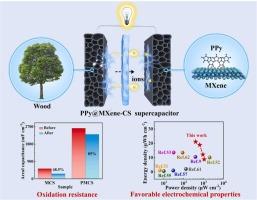构建纤维素骨架衍生的高性能抗氧化超级电容器的自顶向下策略
IF 6.3
2区 材料科学
Q2 CHEMISTRY, PHYSICAL
引用次数: 0
摘要
具有多孔结构和丰富含氧基团的脱木质素纤维素骨架(CS)与功能性MXene协同作用是一种很有前途的高性能储能电极制备策略。然而,MXene在环境条件下的固有不稳定性对MXene- cs (MCS)电极的发展构成了重大挑战。本文通过浸渍和原位加载在CS上构建ppy包封MXene,制备了具有优异抗氧化和电化学性能的Polypyrrole@MXene-CS (PPy@MXene-CS, PMCS)电极。浸渍后的MXene通过氢键作用与CS紧密结合,形成均匀的MCS导电网络。原位封装的聚吡啶不仅增强了MXene的抗氧化性,而且增加了PMCS的伪电容。得益于天然CS孔隙结构和协同电化学储能材料,PMCS电极显示出高达2622 mF cm-2的面积电容(在3 mA cm-2电流密度下),并且在两个月的存储后没有明显的退化。所制备的准固态对称超级电容器具有良好的面积电容(3ma cm-2时为2144.5 mF cm-2)、能量密度(21.6 μWh cm-2)和循环能力(6000次循环后电容保持率为93.2%)。这项工作提出了制造高性能和抗氧化CS电极的突破性策略,为先进的储能技术铺平了道路。本文章由计算机程序翻译,如有差异,请以英文原文为准。

Top-down strategy for constructing cellulose skeleton-derived high-performance supercapacitors with oxidation resistance
Lignin-removed cellulose skeleton (CS) with porous structure and abundant oxygen-containing groups synergized with functional MXene is a promising strategy for constructing high-performance energy storage electrodes. However, the intrinsic instability of MXene under environmental conditions poses a significant challenge to the advancement of MXene-CS (MCS) electrodes. Herein, Polypyrrole@MXene-CS (PPy@MXene-CS, PMCS) electrodes with excellent antioxidant and electrochemical performances are developed by constructing PPy-encapsulated MXene on CS through impregnation and in-situ loading. The impregnated MXene is tightly bound to CS through hydrogen bonding interactions to form the homogeneous MCS conductive network. The in-situ encapsulated PPy not only strengthens the oxidation resistance of MXene, but also imparts the PMCS additional pseudocapacitance. Benefiting from the natural CS pore structure and the synergistic electrochemical energy storage materials, the PMCS electrode demonstrates an area capacitance of up to 2622 mF cm−2 (at 3 mA cm−2 current density) and without significant degradation after two months storage. The assembled quasi-solid-state symmetric supercapacitor exhibits the satisfactory area capacitance (2144.5 mF cm−2 at 3 mA cm−2), energy density (21.6 μWh cm−2) and cycling capability (93.2 % capacitance retention after 6000 cycles). This work presents a breakthrough strategy for fabricating high-performance and oxidation-resistant CS electrodes, paving the way for advanced energy storage technologies.
求助全文
通过发布文献求助,成功后即可免费获取论文全文。
去求助
来源期刊

Journal of Alloys and Compounds
工程技术-材料科学:综合
CiteScore
11.10
自引率
14.50%
发文量
5146
审稿时长
67 days
期刊介绍:
The Journal of Alloys and Compounds is intended to serve as an international medium for the publication of work on solid materials comprising compounds as well as alloys. Its great strength lies in the diversity of discipline which it encompasses, drawing together results from materials science, solid-state chemistry and physics.
 求助内容:
求助内容: 应助结果提醒方式:
应助结果提醒方式:


